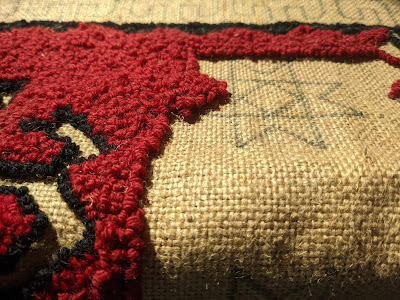It took forty years for me to complete this rug begun by my grandmother, her mother, and other ladies of the family. I received the rug, Juliet Oriential, from my grandmother, Marjorie Isbell Wiley, when I was fourteen and facing the imminent prospect of her demise. This was a prospect I could not fathom; my grandmother's passing broke my heart. I kept the rug, the wool, the hook, the fame, the wool cutter all this time. This winter, I did what my grandmother said and worked on the rug.

When I got to this point, Maeve stood by me and the work. At this stage, I had completed all the work that had been begun by others and was on my own with it.
I worked on this weekend mornings in natural light. When the winter sun was bright, the texture of the various fibers was as clear to my eyes as it was to my fingers.
I was impressed by how the weight of the rug grew as the work progressed. I used wool that my great-grandmother left behind. There were scraps of yarn, strips of fabric, and dyed wool swatches that made their way into the rug. It seemed to me the little squarish crosses received the marginal scraps from other projects. There was no rhyme or reason to the ordering of the colors.
The burlap on which McGown's design was printed is substantial, thick. Before I completed it, I ordered a new cut of burlap to continue practicing my skills. Comparing the two, I am struck by how lightweight the new material is.
In the above image, I am adding a black outline to work done generations, decades, before me. This was a powerful experience. As I worked the rug, I worked around and with previous work. Some of it was very well done, and some of it was not at all. But this was the work of my foremothers, and I wanted to honor it and become a part of it. The loops I am outlining in this image are small and neat, the work of an experienced artisan.

Adding white wool around the center rectangle was exciting. The wool had been part of a garment my great-grandmother had saved. The brightness of the cream brought life to the central field. Working this, I remembered my mother's joking about her grandmother's eyeing anybody in the family with a white wool coat or a white wool dress.
Sorting my great-grandmother's wool swatches and scraps, I encountered penciled notes indicating which swatches were intended for what family member's rugs, which shades of green needed to be checked in the light before being used, what colors would be procured. She was busy always with making things, and always for somebody she loved. I have many of her rugs, and many of them require repair. I look at them and think of my mother's stories of how Nan would take a flower from the garden and take it apart so that she could draw it and copy the coloration properly for when she added the flower to one of her rugs.
Nan worked hard and put her heart and soul into rugs her family would stand on. Stand on those rugs they did, and now, more than half a century later, they need some small repairs. All of this is a metaphor for family: the creating, giving, planning, making, giving, loving, wearing and tearing, restoring, handing on, repairing, seeking understanding, seeking story....I have the rugs.
I began with Julie Oriental to do what my grandmother told me to do 40 years ago: learn how to hook. She chose me from among her daughters and granddaughters. I mattered to her; she believed in me. It took me a while, but I am becoming worthy of the task of repairing Nan's rugs.
Juliet Oriental is now a table covering. The table: a drop-leaf Duncan-Fife style table that my grandmother gave my parents when they were married. It is singed in a few places where it felt the heat of their apartment fire. But they refinished it and used it all their life together. It's mine now, safe and snug under the wool rug my gram said I should finish and did.
In the wool, in the burlap, in the wood of the table, my forebears are here. So is their love. And so it mine.









Sandy Carlson Social